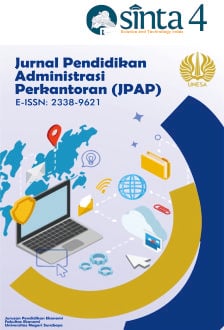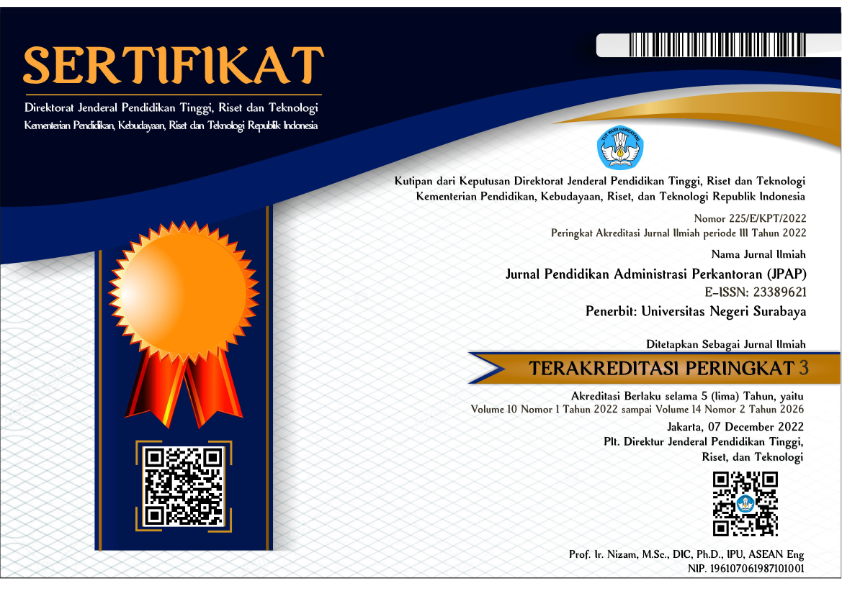Analisis Model Pembelajaran Kooperatif Tipe Two Stay Two Stray (TSTS) Sebagai Upaya Meningkatkan Motivasi Belajar Siswa
DOI:
https://doi.org/10.26740/jpap.v9n2.p270-280Keywords:
Two Stay Two Stray (TSTS), Motivation, General Administration.Abstract
This article aimed to analyze how the two stay two stray type of cooperative learning model can increase student motivation in general administration subjects. Basic competence regarding understanding administration aimed at students to explain, classify and differentiate types of administration. The two stay two stray cooperative learning model is the right model to increase student motivation, because the learning model can build teams, social skills, build knowledge, learning procedures, process information, think skills, and present information. In the implementation of this learning model student-centered to help students more actively think, be responsible, and increase student learning motivation. This type of research is conceptual which proves that the two stay two stray cooperative learning model as an effort to increase student motivation.References
Agarwal, R., & Nagar, N. (2011). Cooperative Learning. India: Kalpaz Publications.
Arianti, R., Akib, H., & Saleh, S. (2017). Penggunaan Model Pembelajaran Kooperatif TipeTwo Stay Two Stray (TSTS) pada Jurusan Administrasi Perkantoran di SMK Negeri 1 Pinrang. Jurnal Office, 3(2), 97106.
Dwipayana, K. E., Natajaya, N., & Sukadi. (2017). Penerapan Model Pembelajaran Kooperatif Tipe Two Stay Two Stray Untuk Meningkatkan Motivasi dan Hasil Belajar Siswa Kelas X AK 1 di SMK Negeri 1 Abang. Jurnal Pendidikan Pancasila Dan Kewarganegaraan, (1).
Fathurrohman. (2015). Model-Model Pembelajaran Inovatif. Yogyakarta: Ar-Ruzz Media.
Hamalik, O. (2015). Kurikulum dan Pembelajaran. Jakarta: PT Bumi Aksara.
Hamdayama, J. (2016). Metodologi Pengajaran. Jakarta: PT Bumi Aksara.
Hanafiah, N., & Suhana, C. (2010). Konsep Strategi Pembelajaran. Bandung: PT Refika Aditama.
Hendra, M. Y., Utaya, S., & Amirudin, A. (2016). Meningkatkan Motivasi Belajar IPS Dengan Model Pembelajaran Two Stay Two Stray Berbantuan Media Power Point. Jurnal Pendidikan Humaniora (JPH), 1(8), 911912.
Huda, M. (2013). Cooperative Learning (Metode, Teknik, Struktur dan Model Penerapan). Yogyakarta: Pustaka Belajar.
Kurnia, N., Degeng, I. N. S., & Soetjipto, B. E. (2013). Model Two Stay Two Stray (TSTS) dan Find Someone Who untuk Meningkatkan Hasil Belajar Kognitif, Afektif dan Psikomotor. Pascasarjana Universitas Negeri Malang, 1.
Kusumawati, N., & Maruti, E. S. (2019). Strategi Belajar Mengajar Di Sekolah Dasar. Magetan: CV. AE Media Grafika.
Lesia, E. S., & Angraini, N. (2017). Using Two Stay-Two Stray (TSTS) To Improve Speaking Achievement of the Tenth Grade Students of SMAN 10 Palembang. 6(1), 16.
Nugrahani, A. S. (2019). Silabus Administrasi Umum.
Pemerintah Indonesia. (2010). Peraturan Pemerintah Republik Indonesia Nomor 17 Tahun 2010 Tentang Pengelolaan dan Penyelenggaraan Pendidikan. Jakarta: Sekretariat Negara, 19(2), 4759.
Rachmawati, Y., & Ernawati, T. (2018). Efektivitas Model Pembelajaran Kooperatif Tipe Two Stay Two Stray Terhadap Hasil Belajar Ipa Ditinjau Dari Motivasi Belajar Siswa. Natural: Jurnal Ilmiah Pendidikan IPA, 5(1), 45.
Rosy, B. (2018). School Based Management; Keefektifan Kurikulum Pembelajaran Ekonomi di SMA Negeri 3 Madiun. Jupeko (Jurnal Pendidikan Ekonomi), 3(1), 92102.
Rozi, F. Y. (2016). Penerapan Model Pembelajaran Kooperatif Tipe Two Stay Two Stray (TSTS ) Untuk Meningkatkan Motivasi Belajar Siswa. 2(1), 5566.
Sahita, N. A., & Rachmawati, L. (2018). Pengaruh Motivasi dan Fasilitas Belajar di Rumah Terhadap Hasil Belajar Ekonomi Kelas X IIS SMA Hang Tuah 1 Surabaya. JPEKA: Jurnal Pendidikan Ekonomi, Manajemen Dan Keuangan, 2(2), 97.
Sardiman. (2011). Interaksi dan Motivasi Belajar-Mengajar. Jakarta: PT RajaGrafindo Persada.
Sardiman. (2016). Interaksi dan Motivasi Belajar-Mengajar. Jakarta: Rajawali Pers.
Siregar, E., & Nara, H. (2015). Teori Belajar dan Pembelajaran. Bogor: Penerbit Ghalia Indonesia.
Sriwijayanti, R. P. (2017). Pengaruh Model Pembelajaran Kooperatif Tipe Two Stay Two Stray (TSTS) Untuk Meningkatkan Motivasi Belajar Mata Pelajaran PPKn. Economica, 6(1), 7286.
Sunadi, L. (2013). Pengaruh Motivasi Belajar Dan Pemanfaatan Fasilitas Belajar Terhadap Prestasi Belajar Siswa Pada Mata Pelajaran Ekonomi Kelas XI IPS di SMA Muhammadiyah 2 Surabaya. Jurnal Pendidikan Ekonomi (JUPE), 1, 119.
Suprijono, A. (2013). Cooperative Learning: Teori dan Aplikasi PAIKEM. Yogyakarta: Pustaka Belajar.
Susanto, A. (2013). Teori Belajar & Pembelajaran di Sekolah Dasar. Jakarta: Prenadamedia Group.
Yuliana, D., Rochsantiningsih, D., & Pudjobroto, H. (2014). Optimizing The Use of Two Stay Two Stray Method To Improve Students Motivation in Learning English. Jurnal Pendidikan Bahasa Inggris. Abstract views: 814
,
Abstract views: 814
, PDF Downloads: 2444
PDF Downloads: 2444










